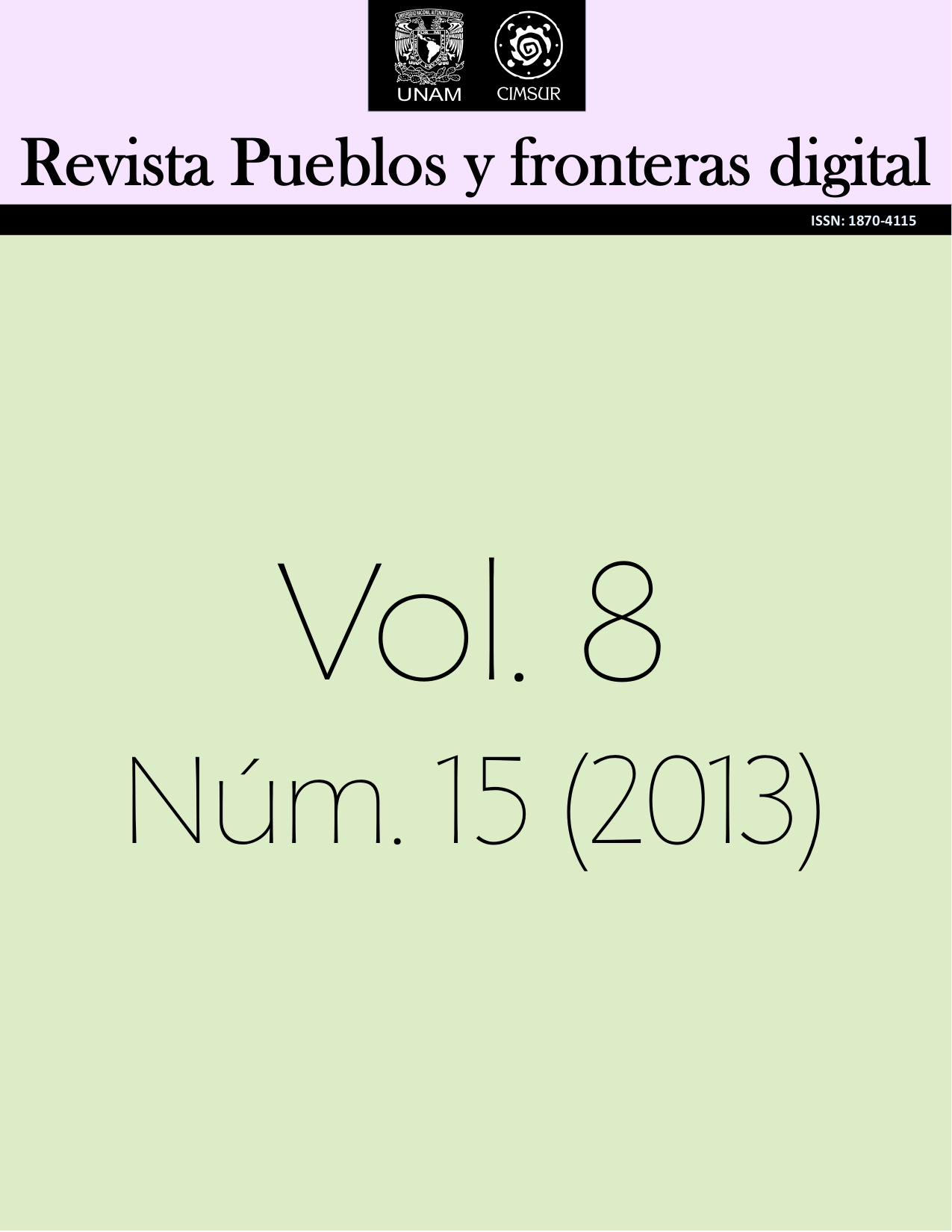Los hijos de inmigrantes mexicanos en Estados Unidos de Norteamérica y sus aspiraciones educativas: una nueva propuesta teórica

Esta obra está bajo una licencia internacional Creative Commons Atribución-NoComercial-SinDerivadas 4.0.
Contenido principal del artículo
Contenido principal del artículo
Resumen
El presente trabajo comparte una propuesta teórica para explorar el proceso de formación de las aspiraciones educativas de los hijos de inmigrantes mexicanos desde la óptica de la vida familiar, tomando en consideración distintos enfoques teóricos. El artículo parte de la aseveración de que «la familia es un punto estratégico para entender las dinámicas de los flujos de la inmigración (legal e ilegal) y del proceso de adaptación del inmigrante» (Rumbaut 1997: 4). La propuesta de análisis plantea abordar el objeto de estudio desde la dinámica interna de la vida familiar. Asimismo, es importante tomar en cuenta el contexto social y cultural del lugar de origen de las familias inmigrantes y el contexto de recepción.
Detalles del artículo
Citas
Alexander, Karl L., Bruce K. Eckland, and Larry J. Griffin, 1975, «The Wisconsin Model of Socioeconomic Achievement: A Replication», American Journal of Sociology, n. 81, pp. 324-342. DOI: https://doi.org/10.1086/226076
Arias, Patricia, 2009, Del arraigo a la diáspora. Dilemas de la familia rural, Miguel Ángel Porrúa, México.
Arias, Patricia (en prensa), «Migración, economía campesina y ciclo de desarrollo doméstico. Discusiones y estudios recientes», en Estudios Demográficos y Urbanos. El Colegio de México, v. 28, n. 82, primer cuatrimestre. DOI: https://doi.org/10.24201/edu.v28i1.1440
Ariza, Marina y Alejandro Portes, 2007, El país trasnacional migración mexicana y cambio social a través de la frontera, IIS UNAM, México.
Breen, R. y J. H. Goldthorpe, 1997, «Explaining educational differentials: towards a formal rational action theory», Rationality and Society, n. 9, pp. 275-305. DOI: https://doi.org/10.1177/104346397009003002
Cerrutti, Marcela y Magalí Gaudio, 2010, «Diferencia de género entre la migración a Estados Unidos y la de Paraguay a la Argentina», en Donato et al., (coords.), Salvando fronteras, Miguel Ángel Porrúa, México, pp. 95-118.
Cordasco, Francesco, 1973, «The children of immigrant in the schools: Historical analogues of educational deprivation», The Journal of Negro Education, v. 42, n. 1, pp. 44-53. DOI: https://doi.org/10.2307/2966790
Dreby, Joanna, 2010, Divided by Borders Mexican migrants and their children, University of California Press, Los Ángeles. DOI: https://doi.org/10.1525/9780520945838
Durand, Jorge, 1994, Más allá de la línea: Patrones migratorios entre México y Estados Unidos, Conaculta, México.
Durand, Jorge y Enrique Martínez Curiel, 1999, «Los nuevos procesos de integración. Matrimonios mixtos, y migración México-Estados Unidos: nuevas tendencias», en Fronteras Fragmentadas. Género, familia e identidades en la migración mexicana al norte, El Colegio de Michoacán, CIDEM, México, pp. 437-449.
Esteinou, Rosario y Daniel Nehring, 2009, «Educación familiar y estilos parentales en México: Una exploración de la Encuesta Nacional de la Dinámica Familiar», en Rosario Esteinou (ed.), Construyendo relaciones y fortalezas familiares, Ciesas, Miguel Ángel Porrúa, México, pp. 87-128.
Fuligni, Andrew J., 1997, «The academic achievement of adolescents from immigrant families: The roles of family background, attitudes, and behavior», Child Development, v. 68, n. 2, pp. 351-363. DOI: https://doi.org/10.1111/j.1467-8624.1997.tb01944.x
Garcia Coll, Cynthia y Katherine Magnunson, 1997, «The Psychological Experience of Immigration: A Developmental Perspective», Immigration and the Family, Laurence Erlbaum Associates Inc., pp. 91-131.
Garrison, Howard H., 1982, «Trends in Educational and Occupational Aspirations of High School Males: Black-White Comparisons» Sociology of Education, n. 55, pp. 53-62. DOI: https://doi.org/10.2307/2112611
Goyette, Kimberly y Yu Xie, 1999, «Educational expectations of Asian American youths: determinants and ethnic differences», Sociology of Education, n. 72, pp. 22-36. DOI: https://doi.org/10.2307/2673184
Grebler, Leo, Joan Moore y Ralph Guzman, 1970, The Mexican American People: The Nation´s Second Largest Minority, New York, Free Press.
Guttormsson, Loftur, 2003, «Las relaciones paternofiliales», en David I. Kertzer y Marzio Barbagli (comps.), Historia de la familia europea, v. 2. Paidós, pp. 369-410.
Haller, Archibald D. y Alejandro Portes, 1973, «Status attainment processes», Sociology of Education, n. 46, pp. 51-91. DOI: https://doi.org/10.2307/2112205
Hao, Lingxing y Melissa Bonstead-Bruns, 1998, «Parent-child differences in educational expectations and the academic achievement of immigrant and native students», Sociology of Education, n. 71, pp. 175-198.
Hao, Lingxing y Bonstead Bruns, M., 1998, «Parent-child differences in educational expectations and the academic achievement of immigrant and native students», Sociology of Education, n. 71, pp. 175-198. DOI: https://doi.org/10.2307/2673201
Hauser, R.M. y Anderson, D. K., 1991, «Post high-school plans and aspirations of black and white high school seniors: 1976-1986», Sociology of Education, n. 64, pp. 263-277. DOI: https://doi.org/10.2307/2112707
Kao, Grace y Marta Tienda, 1995, «Optimism and Achievement: The Educational Performance of Immigrant Youth», Social Science Quarterly, n. 76, pp. 1-21.
Kao, Grace y Marta Tienda, 1998, «Educational aspirations of minority youth», American Journal of Education, n. 106, pp. 349-384. DOI: https://doi.org/10.1086/444188
Khattab Nabil, 2003, «Explaining educational aspirations of minority students: the role of social capital and students’ perceptions», Social Psychology of Education, n. 6, pp. 283302.
Levit, Peggy y Mary C. Waters, 2002, The changing face of home: the transnational lives of the second generation, Russell Sage Foundation, New York.
MacLeod, Jay, 2008, Ain't No Makin' It: Aspirations and Attainment in a Low-Income Neighborhood, Westview Press, Portland.
Marjoribanks, Kevin, 1998, «Family background, social and academic capital, and adolescents’ aspirations: A mediational analysis», Social Psychology of Education, n. 2, pp.177-197.
Martínez Curiel, Enrique, 2003, Hasta que la green card nos separe, Universidad de Guadalajara, México.
Martínez Curiel, Enrique, 2004, «The Green Card as a Matrimonial Strategy: Self-Interest in the Choice of Marital Partners», en Jorge Durand y Douglas S. Massey (eds.), Crossing the Border, Russell Sage Fundation, New York, pp. 86-108.
Massey Douglas, Rafael Alarcón, Jorge Durand y Humberto González, 1991, Los Ausentes. El proceso social de la migración internacional en el occidente de México, Alianza editorial, México.
Mickelson, R. A., 1990, «The attitude-achievement paradox among black adolescents», Sociology of Education, n. 63, pp. 44-61. DOI: https://doi.org/10.2307/2112896
Morgan, S. L., 1996, «Trends in black-white differences in educational expectations, 19801992», Sociology of Education, n. 69, pp. 308-319. DOI: https://doi.org/10.2307/2112717
Ogbu, John U., 1983, «Minority Status and Schooling in Plural Societies», Comparative Education Review, v. 27, n. 2, pp. 168-190. DOI: https://doi.org/10.1086/446366
Ogbu, John U., 1992, «Understanding Cultural Diversity and Learning», Educational Researcher, v. 21, n. 8, pp. 5-14. DOI: https://doi.org/10.3102/0013189X021008005
Ogbu, John. U. y Simons, H. D., 1998, «Voluntary and involuntary minorities: A CulturalEcological Theory of school performance with some implications for education», Anthropology and Education Quarterly, n. 29, pp. 155-188. DOI: https://doi.org/10.1525/aeq.1998.29.2.155
Portes Alejandro y Jay MacLeod, 1996, «Educational Progress of Children of Immigrants: The Roles of Class, Ethnicity, and School Context», Sociology of Education, v. 69, n. 4, pp. 255-275. DOI: https://doi.org/10.2307/2112714
Portes Alejandro y Min Zhou, 1992, «Gaining the upper hand: economic mobility among immigrant and domestic minorities», Ethnic and Rural Studies, v. 15, pp. 491-522. DOI: https://doi.org/10.1080/01419870.1992.9993761
Portes, Alejandro y Min Zhou, 1993, «The New Second Generation: Segmented Assimilation and Its Variants», Annals of the American Academy of Political and Social Science, n. 530, pp. 74-96. DOI: https://doi.org/10.1177/0002716293530001006
Portes, Alejandro y Rubén G. Rumbaut, 1996, Immigrant America: A Portrait, University of California Press, Los Angeles.
Portes, Alejandro y Rubén G. Rumbaut, 2001, Ethnicities, University of California Press, Los Angeles.
Portes, Alejandro, Patricia Fernández-Kelly y William Haller, 2009, «The Adaptation of the Immigrant Second Generation in America: A Theoretical Overview and Recent Evidence», Journal of Ethnic and Migration Studies, v. 35, n. 7, agosto, pp. 1077-1104. DOI: https://doi.org/10.1080/13691830903006127
Portes, Alejandro, 2006, «La nueva nación latina: inmigración y la población hispana de los Estados Unidos», Reis, n. 116, pp. 55-96. DOI: https://doi.org/10.2307/40184808
Rumbaut, Rubén G., 1997, «Ties that bind: Immigration and immigrant families in the United States» Immigration and the Family, Laurence Erlbaum Associates Inc., pp. 3-46.
Russell Rumberger, 1983, «Dropping out of High School: The influence of race, sex and family background», American Educational Research Journal, v. 20, n. 2, pp. 199-220. DOI: https://doi.org/10.3102/00028312020002199
Scheneider, B. y D. Stevenson, 1999, The ambitious generation: America’s teenagers, motivated but directionless, Yale University Press, New Haven and London.
Schmid, Carol L., 2001, «Educational achievement, Language-Minority students and the new second generation», Sociology of Education, v. 74, pp. 71-87. DOI: https://doi.org/10.2307/2673254
Sewell, William. H., 1971, «Inequality of Opportunity for Higher Education», American Sociological Review, n. 36, pp. 793-809. DOI: https://doi.org/10.2307/2093667
Sewell, William H. y Vimal P. Shah, 1968, «Parents’ Education and Children's Educational Aspirations and Achievements», American Sociological Review, n. 33, pp. 191-209. DOI: https://doi.org/10.2307/2092387
Sewell, William H., Archibald O. Haller, and George W. Ohlendorf, 1970, «The Educational and Early Occupational Status Attainment Process: Replication and Revision», American Sociological Review, n. 35, pp. 1014-1027. DOI: https://doi.org/10.2307/2093379
Sewell, William H. y Robert M. Hauser, 1980, «The Wisconsin Longitudinal Study of Social and Psychological Factors in Aspirations and Achievements», Research in Sociology of Education and Socialization, n. 1, pp. 59-99.
Sewell, William H. y Robert M. Hauser, 1993, A Review of the Wisconsin Longitudinal Study of Social and Psychological Factors in Aspirations and Achievements 1963-1992, Department of Sociology, The University of Wisconsin, Madison.
Solórzano, D. G., 1992, «An exploratory analysis of the effects of race, class, and gender on student and parent mobility aspirations», Journal of Negro Education, n. 61, pp. 30-43. DOI: https://doi.org/10.2307/2295627
Smith, Robert Courtney, 2006, México en Nueva York, UAZ, Miguel Ángel Porrúa, México.
Smith, Timothy. L., 1969, «Immigrant social aspirations and American education, 18801930», American Quarterly, v. 21, n. 3, pp. 523-543. DOI: https://doi.org/10.2307/2711932
Telles, Edward E. y Vilma Ortiz, 2008, Generations of Exclusion Mexican Americans Assimilation and Race, Russell Sage Fundation, New York.
Warren, John Robert, 1996, «Educational inequality among White and Mexican-origin adolescents in the American southwest:1990», Sociology of Education, n. 69, pp. 142-158. DOI: https://doi.org/10.2307/2112803
Wolf, D. L., 1990, «Daughters, Decisions and Domination: An Empirical and Conceptual Critique of Household Strategies», Development and Change, v. 21, pp. 43-74. DOI: https://doi.org/10.1111/j.1467-7660.1990.tb00367.x
Zhou, Min, 1997, «Segmented Assimilation: Issues, Controversies, and Recent Research on the New Second Generation», International Migration Review, v. 31, n. 4, pp. 975-1008. DOI: https://doi.org/10.1177/019791839703100408







